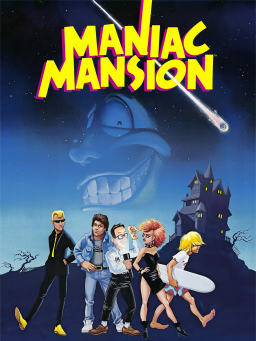
Maniac Mansion is a 1987 graphic adventure video game developed and published by Lucasfilm Games. It follows teenage protagonist Dave Miller as he attempts to rescue his girlfriend Sandy Pantz from a mad scientist, whose mind has been enslaved by a sentient meteor. The player uses a point-and-click interface to guide Dave and two of his six playable friends through the scientist's mansion while solving puzzles and avoiding dangers. Gameplay is non-linear, and the game must be completed in different ways based on the player's choice of characters. Initially released for the Commodore 64 and Apple II, Maniac Mansion was Lucasfilm Games' first self-published product.
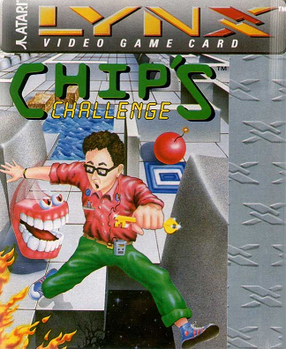
Chip's Challenge is a top-down tile-based puzzle video game originally published in 1989 by Epyx as a launch title for the Atari Lynx. It was later ported to several other systems and was included in the Windows 3.1 bundle Microsoft Entertainment Pack 4 (1992), and the Windows version of the Best of Microsoft Entertainment Pack (1995), where it found a much larger audience.

The 7th Guest is an interactive movie puzzle adventure game, produced by Trilobyte and originally released by Virgin Interactive Entertainment in April 1993. It is one of the first computer video games to be released only on CD-ROM. The 7th Guest is a horror story told from the unfolding perspective of the player, as an amnesiac. The game received press attention for making live action video clips a core part of its gameplay, for its then-unprecedented amount of pre-rendered 3D graphics, and for its adult content. The game was very successful, with over two million copies sold. The game alongside Myst, is widely regarded as a killer app that accelerated the sales of CD-ROM drives. The 7th Guest has subsequently been re-released on Apple's app store for various systems such as the Mac. Bill Gates called The 7th Guest "the new standard in interactive entertainment".

Gahan Allen Wilson was an American author, cartoonist and illustrator known for his cartoons depicting horror-fantasy situations.
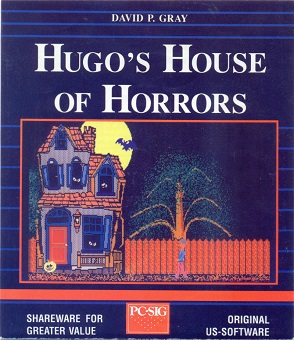
Hugo's House of Horrors is a parser-based adventure game designed by independent software developer David P. Gray and published as shareware in 1990. The game follows the character Hugo as he searches for his girlfriend Penelope in a haunted house. To progress through the game, the player uses items and interacts with the environment to solve puzzles and access more rooms in the house. The gameplay was inspired by Leisure Suit Larry in the Land of the Lounge Lizards. Hugo's House of Horrors was praised for its environment and atmosphere, but it was criticized for its plot and visual design. It was followed by two sequels: Hugo II, Whodunit? and Hugo III, Jungle of Doom!, and a spin-off first-person shooter game, Nitemare 3D.
The Eggerland (エッガーランド) series consists of several puzzle games developed by HAL Laboratory. Its first release was in 1985 for MSX computer systems. The gameplay is almost exactly the same across the series, with only a few changes over the years, mainly graphical.

Rama is a point and click adventure game, developed and published by Sierra On-Line, and released on DOS and Microsoft Windows in 1996; PlayStation version was released in 1998, but exclusively in Japan. The game is based upon Arthur C. Clarke's books Rendezvous with Rama and Rama II, combining elements of their plots with a story that sees the player assuming the role of a replacement crew member for an expedition to investigate an instellar ship and uncover its mysteries.
3-D Ultra Pinball is a series of pinball computer games developed by Sierra Entertainment's Dynamix. The games try to escape from the traditional, arcade pinball and feature animation, more than one table at once, and "temporary targets".

Monster Max is a 1994 action-adventure puzzle video game developed by Rare and published by Titus France in Europe for the Game Boy. The player is the titular aspiring rock star, who, in an attempt to fight King Krond who bans all music, traverses nine floors of the Mega Hero Academy. Floors consist of diversely-designed rooms of puzzles to solve, the player having to figure out the order of actions to take.
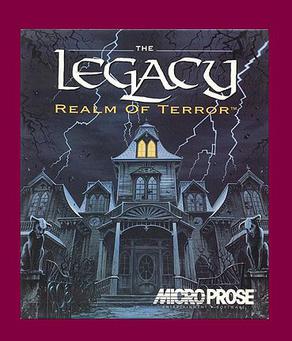
The Legacy: Realm of Terror is a horror role-playing video game developed by Magnetic Scrolls and published by MicroProse for the PC DOS in 1992–1993. A special collector's edition was released by RadioShack. A cancelled version of the game for the Amiga was in development in 1993. It was released digitally on December 20, 2019 by Piko Interactive on GOG.com with support for Microsoft Windows, macOS, and Linux pre-packed with DOSBox.

Dragon Lore: The Legend Begins is a point-and-click adventure game released in 1994 by Cryo Interactive for MS-DOS, and later ported to the 3DO video game console. The game was a commercial success, with sales of 300,000 units by 1997. An emulated version was released for Microsoft Windows and macOS in 2013.
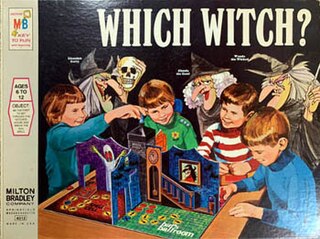
Which Witch? is a children's board game published in 1970 by the Milton Bradley Company, and was invented by Joseph M. Burck of Marvin Glass and Associates. The board represents a haunted house with four large rooms: the Broom Room, the Witchin' Kitchen, the Spell Cell and the Bat's Ballroom, assembled before play into a three-dimensional model house with vertical walls, and a large plastic chimney in the center. There are four tokens, colored red, yellow, blue and green. Each token is shaped like a child, either a boy or a girl, with four corresponding mouse tokens of identical color.

Hellnight, known as Dark Messiah in Japan, is a first-person survival horror video game developed by Dennou Eizou Seisakusho and published by Atlus Co. in collaboration with Konami in 1998. The game is an adventure game with 3D.

Scooby-Doo Mystery is the name of two video games released by Acclaim Entertainment in 1995 and licensed by Sunsoft based on the Scooby-Doo animated series. One of the games was released for the Sega Genesis and features a more traditional adventure game-style interface. The other title, released for the Super Nintendo Entertainment System, is an adventure game with platforming elements. Both were released only in North America. In both games, players take control of Shaggy Rogers and Scooby-Doo, who help solve various mysteries with other members of Mystery Incorporated who serve minor roles during gameplay.
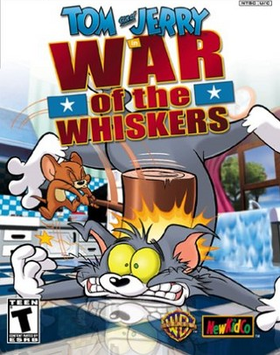
Tom and Jerry in War of the Whiskers is a fighting video game developed by VIS Entertainment, published by NewKidCo for PlayStation 2, GameCube, and Xbox. It is the sequel to the 3D cartoon fighting video game Tom and Jerry in Fists of Furry for Nintendo 64 and Microsoft Windows. It allows up to four players to play simultaneously. It is the only NewKidCo game and the only Tom and Jerry game, released to receive a T rating. The PlayStation 2 version was released in all major regions, and the GameCube and Xbox versions were only released in North America. The game received mixed reviews from critics, with Metacritic scores of 63/100, 64/100, and 50/100 on PlayStation 2, GameCube, and Xbox, respectively.
Chocolate Castle is a puzzle video game developed by New Zealand–based company Lexaloffle and published on April 2, 2007. The game was developed by Lexaloffle's owner and operator Joseph White, who designed Chocolate Castle as a platform for further puzzle games. In this game, players clear a castle's rooms of chocolate by combining smaller pieces into large bars and commanding animals to consume them. After clearing a room, they can select new rooms that are still yet to be cleared. The full version of the game includes a room editor for players to create their own rooms; players may upload these newly created rooms to Lexaloffle's website for other players to attempt.

Moonlight Madness is a platform game for the ZX Spectrum home computer, published in 1986 by Bubble Bus Software. The player controls a boy scout attempting to unlock a safe within a mansion to obtain pills for the mansion's owner, a mad scientist, who has collapsed. This requires the player to traverse the mansion's rooms while avoiding hazards such as dangerous house servants and fatal falls.

Magrunner: Dark Pulse is a puzzle game developed by Frogwares. It was released as a downloadable title on Microsoft Windows on 20 June 2013, PlayStation Network on 23 October 2013, and Xbox Live Arcade on 25 October 2013. Magrunner: Dark Pulse is set in a cyberpunk reimagining of H. P. Lovecraft's Cthulhu Mythos.

Maid of Sker is a 2020 first-person survival horror game developed and published by Wales Interactive. The game is set in 1898 in the Sker Hotel, on an imaginary island called Sker Island. The protagonist, Thomas Evans, is invited by his lover, Elisabeth Williams, to uncover the mysteries of the hotel after she notices her family's strange behavior. While exploring the hotel, Thomas learns cult followers called "The Quiet Ones" control the place. He finds notes and gramophone records scattered around the hotel that reveal the history of Elisabeth's family.

Lego Monster Fighters was a Lego theme based on Universal Studios Monsters from the horror fiction genre. The Monster Fighters fight against the Lord Vampyre's monsters while collecting the moonstones. The story takes place in the Monster Realm and it's similar to The Monster Squad film. The theme was first introduced in May 2012. It was eventually discontinued by the end of December 2014. The theme also produced a range of associated media, including theme park attractions, several shorts, video game, app and publications.
















